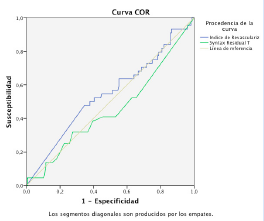The SYNTAX Revascularization Index and major cardiovascular events in patients with multivessel coronary artery disease in the Instituto Nacional de Cardiología Ignacio Chávez – Mexico
DOI:
https://doi.org/10.47487/apcyccv.v4i1.282Keywords:
Myocardial Revascularization, Percutaneous Coronary Intervention, Coronary Artery Bypass, Coronary DiseaseAbstract
Objective. To evaluate the degree of incomplete revascularization in patients with multiarterial coronary artery disease who underwent percutaneous coronary intervention (PCI) or coronary artery bypass surgery (CABG) using the Syntax revascularization index (SRI) and its relationship to major cardiovascular events during follow-up. Materials and Methods. Observational, retrospective study with 4-year follow-up of patients with multiarterial coronary artery disease who underwent surgical or percutaneous coronary revascularization, in whom the baseline Syntax score (SSb) and the residual
Syntax score (SSr) were calculated. The Syntax Revascularization Index (SRI) was determined with
the following formula: SRI = (1- [SSr/SSb]) x 100, and major cardiovascular events at 4-year follow-up were compared. Results. Two hundred patients (100 in each group) were evaluated. Mean SSr in group 1 was 83.2%, and in group 2, 79.0% (p=0.88). Mean complete revascularization was 41% in the first group and 35% in the second. A cutoff point of ≤90% of IRS had the best accuracy for predicting major cardiovascular events (area under the curve of 0.60; 95% CI: 0.49-0.71, p<0.05). In multivariate analysis IRS was an independent predictor of major cardiovascular events (HR 2.6; 95%CI: 1.32-3.22, p= 0.043). Conclusions. The Syntax Revascularization Index may be useful for measuring the degree of revascularization in patients with multiarterial coronary artery disease treated percutaneously or surgically. An SRI ≥90% may be an acceptable target for revascularization.
Downloads
References
Neumann FJ, Sousa-Uva M, Ahlsson A, Alfonso F, Banning A, Benedetto U, et al. 2018 ESC/EACTS Guidelines on myocardial revascularization. Eur Heart J. 2019;40(2):87-165. doi: 10.1093/eurheartj/ehy394.
Hannan EL, Wu C, Walford G, Holmes D, Jones R, Sharma S, et al. Incomplete revascularization in the era of drug-eluting stents: impact on adverse outcomes. JACC Cardiovasc Interv. 2009;2(1):17-25. doi: 10.1016/j.jcin.2008.08.021. PMID: 19463393.
Farooq V, Serruys P, Bourantas C, Zhang Y, Muramatsu T, Feldman T, et al. Quantification of Incomplete Revascularization and its Association With Five-Year Mortality in the Synergy Between Percutaneous Coronary Intervention With Taxus and Cardiac Surgery (SYNTAX) Trial Validation of the Residual SYNTAX Score. Circulation. 2013;128(2):141-51. doi: 10.1161/CIRCULATIONAHA.113.001803
Généreux P, Palmerini T, Caixeta A, Rosner G, Green P, Dressler O, et al. Quantification and Impact of Untreated Coronary Artery Disease After Percutaneous Coronary Intervention The Residual SYNTAX (Synergy Between PCI With Taxus and Cardiac Surgery) Score. J Am Coll Cardiol. 2012;59(24):2165-74. doi: 10.1016/j.jacc.2012.03.010.
Hambraeus K, Jensevik K, Lagerqvist B, Lindahl B, Carlsson R, Farzaneh-Far R, et al. Long-Term Outcome of Incomplete Revascularization After Percutaneous Coronary Intervention in SCAAR (Swedish Coronary
Angiography and Angioplasty Registry). JACC Cardiovasc Interv. 2016;9(3):207-215. doi: 10.1016/j.jcin.2015.10.034.
Zimarino M, Ricci F, Romanello M, Di Nicola M, Corazzini A, De Caterina R. Complete Myocardial Revascularization Confers a Larger Clinical Benefit When Performed With State-of-the-Art Techniques in High-Risk Patients With Multivessel Coronary Artery Disease: A Meta-Analysis of Randomized and Observational Studies. Catheter Cardiovasc Interv. 2016;87(1):3-12. doi: 10.1002/ccd.25923.
Rosner GF, Kirtane AJ, Genereux P, Lansky A, Cristea E, Gersh B, et al. Impact of the presence and extent of incomplete angiographic revascularization after percutaneous coronary intervention in acute coronary syndromes: the Acute Catheterization and Urgent Intervention Triage Strategy (ACUITY) trial. Circulation. 2012;125(21):2613-20. doi: 10.1161/CIRCULATIONAHA.111.069237.
De Bruyne B. Multivessel disease: from reasonably incomplete to functionally complete revascularization. Circulation. 2012;125(21):2557-9. doi: 10.1161/CIRCULATIONAHA.112.106872.
Dauerman HL. Reasonable incomplete revascularization. Circulation. 2011;123(21):2337-40. doi: 10.1161/CIRCULATIONAHA.111.033126.
Kim YH, Park DW, Lee JY, Kim WJ, Yun SC, Ahn JM, et al. Impact of angiographic complete revascularization after drug-eluting stent implantation or coronary artery bypass graft surgery for multivessel coronary artery disease. Circulation. 2011;123(21):2373-81. doi: 10.1161/CIRCULATIONAHA.110.005041.
Taggart DP. Incomplete revascularization: appropriate and inappropriate. Eur J Cardiothorac Surg. 2012;41(3):542-3. doi: 10.1093/ejcts/ezr298.
Schwartz L, Bertolet M, Feit F, Fuentes F, Sako E, Toosi M, et al. Impact of completeness of revascularization on long-term cardiovascular outcomes in patients with type 2 diabetes mellitus: results from the Bypass Angioplasty Revascularization Investigation 2 Diabetes (BARI 2D). Circ Cardiovasc Interv. 2012;5(2):166-73. doi: 10.1161/CIRCINTERVENTIONS.111.963512.
Gössl M, Faxon DP, Bell MR, Holmes D, Gersh B. Complete versus incomplete revascularization with coronary artery bypass graft or percutaneous intervention in stable coronary artery disease. Circ Cardiovasc Interv. 2012;5(4):597-604. doi: 10.1161/CIRCINTERVENTIONS.111.965509.
Ong AT, Serruys PW. Complete revascularization: coronary artery bypass graft surgery versus percutaneous coronary intervention. Circulation. 2006;114(3):249-55. doi: 10.1161/CIRCULATIONAHA.106.614420.
Généreux P, Campos CM, Yadav M, Palmerini T, Caixeta A, Xu K, et al. Reasonable incomplete revascularization after percutaneous coronary intervention: the SYNTAX Revascularisation Index. EuroIntervention. 2015;11(6):634-42. doi: 10.4244/EIJY14M10_05.
Melina G, Angeloni E, Refice S, Benegiano C, Lechiancole A, Roscitano A, et al. Residual SYNTAX Score and Survival Following Coronary Artery Bypass Grafting: Analysis of 1608 Patients. Circulation 2014;130(S2): A16388. doi: 10.1161/circ.130.suppl_2.16388.
Lluberas S, Jubany L, Esmite N. Impact of Untreated Coronary Artery Disease After Percutaneous Coronary Intervention in Patients With Prior CABG: The Residual CABG SYNTAX score. J Am Coll Cardiol. 2014;64(11 Suppl):B27. doi: 10.1016/j.jacc.2014.07.119.
Farooq V, Girasis Ch, Magro M, Onuma Y, More MA, Heo JH, et al. The CABG SYNTAX Score - an angiographic tool to grade the complexity of coronary disease following coronary artery bypass graft surgery: from the SYNTAX Left Main Angiographic (SYNTAX-LE MANS) substudy. EuroIntervention. 2013;8(11):1277-85. doi: 10.4244/EIJV8I11A196.
Mohr FW, Morice MC, Kappetein AP, Feldman T, Stáhle E, Colombo A, et al. Coronary artery bypass graft surgery versus percutaneous coronary intervention in patients with three-vessel disease and
left main coronary disease: 5-year follow-up of the randomised, clinical SYNTAX trial. Lancet. 2013;381(9867):629-38. doi: 10.1016/S0140-6736(13)60141-5.
Cutlip D, Windecker S, Mehran R, Boam A, Cohen D, van Es GA, et al. Circulation. 2007;115(17):2344-51. doi: 10.1161/CIRCULATIONAHA.106.685313.

Downloads
Published
Issue
Section
License
Copyright (c) 2023 The journal is headline of the first publication, then the author giving credit to the first publication.

This work is licensed under a Creative Commons Attribution 4.0 International License.














